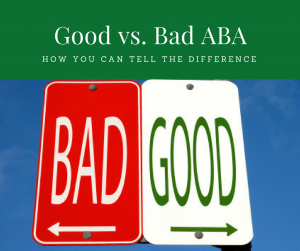
We often encounter misconceptions about what ABA is and what it is not. As with any therapeutic method out there, there are ways to use it and there are ways to abuse it. Unfortunately, the wrong application of the principles at the wrong time or with the wrong student can be detrimental to a child and his/her family. The principles of ABA are based on scientific, peer-reviewed studies and are effective. There is no such thing as bad ABA but there can be bad ABA providers.
How can a family tell the difference between good and bad ABA providers?
ABA Should Be Fun
The best sign of a good ABA relationship is when the therapist comes to the door and the child runs to greet her and is excited to spend time with the therapist. This doesn’t mean that every therapy session will be fun and easy – there may be tears and struggles but overall the child enjoys the relationship that he/she is building with the therapist. The best way to build this relationship is with some time spent “pairing”. In ABA, this means that the therapist pairs her presence with fun, reinforcing activities and puts little demands on the child at first. It is an important step in relationship building. We also encourage therapists to bring their own bag of fun toys and activities that she brings with and takes home when she leaves. When the therapist knocks on the door, the child is excited to see what toys are in the bag. Switching up the toys every once in awhile adds to the excitement!
Language Should be Positive
Expectations should be phrased positively. Identifying the positive opposite of all behaviours can be tricky but it’s now become second nature. Instead of reminding the child what we DON’T want her to do, we talk about what we DO want her to do. Instead of “don’t jump” we might say “quiet body” or instead of “stop talking” we might say “quiet mouth”. If you’re hearing a lot of negative talk between the therapist and the child, it might be a warning sign that it’s not a good fit.
Refrain From Punishment
As Behaviour Analysts we are held by a code of ethical conduct. Part of that code states that, “Behaviour analysts recommend reinforcement rather than punishment whenever possible. If punishment procedures are necessary, we always include reinforcement procedures for alternative behaviour in the behaviour change program”. Punishment means that we’re using methods to REDUCE a negative behaviour. For example, if a child were hitting others, this would be a behaviour that we want to reduce. However, instead of punishing (reducing) “hitting” we can reward the positive opposite of “quiet or appropriate hands”. Reinforcement for the desired behaviour makes it more reinforcing than the other. Increasing behaviours we do want is more ethical than decreasing behaviours we don’t want. Be wary of interventions where students “lose” points or rewards. Before any cost-response or punishment system is considered, we need to exhaust every possible positive intervention.
Reinforcement Should Not be Threatening
Offering a reward as reinforcement should speak for itself. We try to stick to the Premack principle, “first get dressed, then you can go outside”. The first/then principle is one of the first skills that we want our students to learn. Once they understand the principle, there should be no need for threats. You should not be hearing things like, “If you don’t get dressed now, you won’t be able to go outside.” As long as the first/then is in place, the child can access reinforcement as soon as the first task is accomplished. If the first task took too long (for example, recess was over), you can say something like “Oh well, we can try again next time”.
Know Your Rights
If you’re not comfortable with your ABA provider, know that you have a say. The benefit or hiring someone who is certified by the BACB (RBT, BCaBA, or BCBA) means that there is a process available to for filing a complaint. Be wary of ABA providers that do not have certification under the BACB because they are not bound by our code of ethics and there isn’t much you can do when you’re not happy with them. For more information, check www.bacb.com.



Pingback: School Readiness - How to ABA